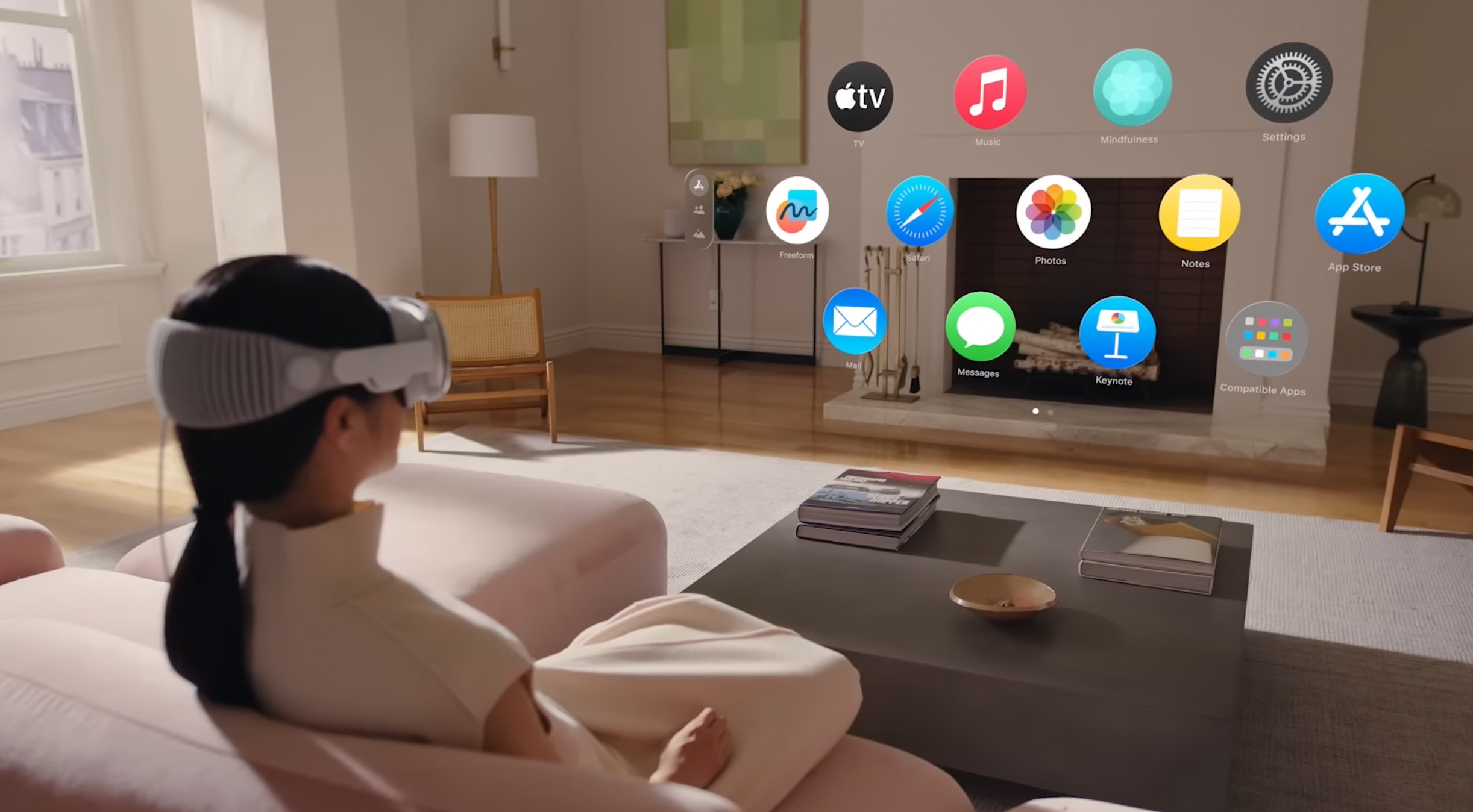Apple Pushes ‘Spatial Computing’ With Vision Pro Headset

Apple successfully builds on familiar iPhone, iPad experience with mixed-reality Vision Pro headset, but analysts say appeal remains limited
Apple’s new Vision Pro headset, announced on Monday, is a significant step forward for the world of virtual reality/augmented reality/mixed reality devices, industry watchers said, while cautioning that it remains uncertain what sort of appeal such devices may actually have for people.
The company took a notably different line when pitching the Vision Pro compared to competitors such as Sony or Facebook parent Meta Platforms, which have principally focused on games or fully immersive “metaverse” social experiences.
Instead the firm highlighted the continuity with its other products, such as the iPhone, iPad and Apple Watch, in a concept it calls “spatial computing”.
Chief executive Tim Cook, who spearheaded the project, said the device “seamlessly blends the real world and the virtual world”.

‘Spatial computing’
“Spatial computing” means, for instance, that the device starts up with a view of the user’s surroundings overlaid with a familiar home screen showing a list of apps, not so different from the home screen of an iPhone or an iPad.
iOS and iPadOS apps will mostly run on the Vision Pro unmodified, or with minimal modifications, Apple says, while those who tried out the device said its gesture-based interface was easy to learn because of its similarity to touchscreen gestures.
Instead of thrusting users immediately into a virtual world, the headset emphasises the use of apps on virtual screens that appear on top of a crisp view of the user’s surroundings generated by an array of high-resolution cameras on the outside of the device.
Cook said users would be able to “see, hear and interact with digital content just like it’s in your physical space”.

Familiar experience
FaceTime video calls, for instance, allow the user to arrange video feeds for multiple users in the virtual space around them, mixing these into the rest of their virtual workspace while continuing to display their surroundings in the background.
CCS Insight analyst Ben Wood, who attended the launch event at Apple Park, said he had been “openly sceptical” about what could be achieved with headsets, but was won over by the company’s approach.
“The headset is able to offer an experience that is immediately familiar to existing Apple device users,” he wrote in a blog post.
“This arguably puts Apple in a strong position to define the future direction of what it is referring to as ‘spatial computing'”.
Some quick thoughts on the design of the Apple Vision Pro. Compared to some of the plasticky headsets we’ve seen so far this really is an ultra-premium design – the curved glass exterior is very striking. #WWDC23 pic.twitter.com/RzSTMbUSUv
— Leo Gebbie (@LeoGebbie) June 5, 2023

‘Sensational’ hardware
CCS’ Leo Gebbie remarked on Twitter that the headset’s “ultra-premium design” sets it well apart from the “plasticky headsets we’ve seen so far”.
“The curved glass exterior is very striking,” he noted.
Like some other observers, Wood noted that the “hardware is sensational” and the “usability is also outstanding”.
“It is so intuitive that after just a couple of minutes of using the device you almost forget you are tapping your fingers together to select items, move screens around or swipe items around the room,” he wrote.

Immersive 3D
The company also highlighted the device’s use for displaying immersive 3D environments recorded from exotic locations, or as a home theater displaying high-resolution entertainment content on a screen as large as is desired.
The Vision Pro’s spatial audio features and ability to display 3D content mean that the experience is comparable or superior to that of viewing a film such as Avatar: The Way of Water in a multiplex, according to analysts who tried out the gadget.
Wood noted that Apple users would “find all their content ready and waiting, be that photos, TV subscriptions and a host of familiar apps”, all “in the most stunning quality I’ve ever seen, given the dual 4K displays”.
But while the Vision Pro pushes the boundaries of what’s possible with a headset, it also highlights the inherent limitations of the format, analysts said.

Limitations
When carrying out an immersive FaceTime call, for instance, it isn’t possible for the other people on the call to see the user’s face, so instead they’re shown a high-resolution avatar – which rather defeats the purpose of holding a video call in the first place.
Similarly, the ability to immerse oneself in a high-quality cinema experience might be ideal for a long flight, but when used at home it would be a paradoxically solitary experience, again seemingly defeating the purpose of an inherently social activity – although Apple staff suggested users could get around this limitation by purchasing several of the $3,499 (£2,849) headsets.
In a sign that Apple itself is still evolving its strategy, Cook said the first-generation Vision Pro was “the beginning of a journey”.
Industry watchers noted that the price tag was even higher than analysts had expected, at roughly seven times the $499 Meta Quest Pro announced last week and nearly 12 times the price of the biggest-selling headset, the $299 Quest 2.

Sticker shock
But as Wood noted, not long ago it would have been “unthinkable” that people would pay $1,500 for a smartphone.
“I won’t be surprised to see people queuing up to buy the product when it starts shipping,” he wrote.
The Vision Pro requires multiple steps to set up, including a facial scan for the creation of a digital avatar and the insertion of prescription lenses for those who wear glasses – another sign that it is not intended to immediately become a hit with a mass audience.
Apple said it plans to begin selling the device – which is reportedly still being finalised – in the US in early 2024.
It has not yet discussed when the Vision Pro might go on sale in other countries.

